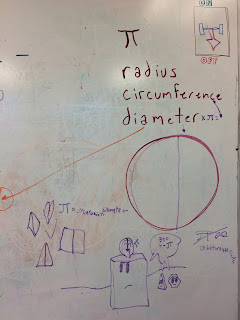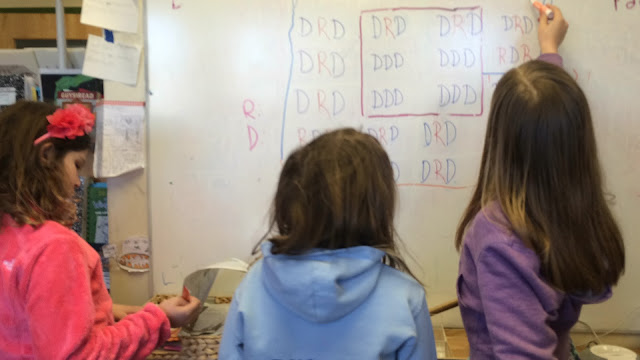 |
| Music Class |
We've had a busy week! Here's a sampling of what's been going on lately.
On Monday, our class led the weekly, school-wide assembly. We opted to talk about our work in the Place Out of Time project. After a quick explanation of what Place Out of Time (POOT) actually is, we demonstrated the "POOT Switch." This is the switch found in our classroom that I periodically flip for classroom conversations that are conducted entirely as our POOT characters. It's a fun (and slightly terrifying) aspect of the POOT experience. When the POOT switch is flipped to "ON," kids know that I will only address them as their characters. If they attempt to respond in any way as "themselves," they know that I will treat them as if they are still their character, but having some sort of episode. POOT works best if everyone is buying into the concept, and this is invaluable (and fun!) practice.
We've prepared for this activity in two ways. First, we've learned some of the basic rules of improvisational theater. There are many schools of thought in improv, but there are some fairly universal tenets that are actually pretty useful tools for everyday life. The most ubiquitous of those rules is "Yes, and..."
The basic idea is that when you are improvising, you must accept whatever is given to you, and then build on it. If I address you as if you are former President Richard Nixon, you not only have to accept it, but add to the conversation. You can never "negate" something that's been offered, or the whole thing falls apart.
The second concept that we've used for this activity is "No Permanent Damage." We're all filled with all sorts of fears, both rational and the opposite. How can you distinguish a fear that is keeping you safe, from a fear that is keeping you from experiencing something positive?
Here is a simple test that you can conduct any time you're deciding whether or not to engage in an activity that is causing you apprehension: If you're feeling nervous or unsure about something, ask yourself, "By doing this, am I exposing myself to a risk that could potentially cause me true and permanent damage? Might I lose a toe, go blind, or earn an unsightly scar?"
If the answer is no, go ahead and try it! For example, the worst case scenario of improvising as a historical figure in front of your classmates is that you might be a little embarrassed if you say something truly ridiculous. Embarrassment isn't permanent damage, so you can feel safe giving it a whirl.
Everyone involved did a great job of rolling with the questions that I asked them, and part of the fun of the exercise is wriggling your way out of answering a question that you are unsure about. For example, I asked Kaz (portraying futbol legend Pelé) how his children felt about his fame. Kaz had no idea what the real Pelé felt about this, so he responded with, "I don't talk about my children publicly." Brilliant!
 We combined our math group with Sam's to discuss the concept of Pi in a number of ways. The most important thing that came from the day was talking about how mathematics is much, much more than arithmetic.
We combined our math group with Sam's to discuss the concept of Pi in a number of ways. The most important thing that came from the day was talking about how mathematics is much, much more than arithmetic. A significant part of elementary and middle school math revolves around learning arithmetic: Addition, subtraction, multiplication, and division. It gets dressed up a bit the further along you get (fractions, decimals, ratios, percentages, etc), but it's ultimately all still the same thing: addition, subtraction, multiplication, and division. They are crucial tools to learn, but they're still just tools. Math is much more than that.
 |
| Sam returns! He shared photos of his new daughter Maddy, as well as pie! |
This election season... Oof. As you might imagine, the kids have it on their minds. We used it this week to demonstrate some applied mathematics that goes beyond simple arithmetic.
 |
| The branches of government. We've gone over this a few times over the last few weeks as we've tried to understand exactly what the President of the United States can and cannot do. |
We talked about how the United States has a representative democracy, not a direct democracy. A direct democracy would find us voting on each and every single proposed law at the local, state, and federal level. Few of us have the time for this, so we elect representatives to vote in our best interests instead. It's a useful system, but there are issues with it. One of them is that people have been using math to game the system for generations: Gerrymandering.
We talked about gerrymandering as a concept, and looked at some examples of it in action. First up is a very clear model of how it works:
Here's the political cartoon that first articulated the practice:
Here are some notoriously gerrymandered congressional districts in the United States:
 |
 |
| In this particular scenario, the Democrats outnumber the Republicans. However, it is possible to draw four districts (with six "cities" each) that allows the Republicans to win the election. (It must be noted that all political parties have been guilty of engaging in this practice.) |
Math and civics! It turns out that they have a lot to do with one another!







No comments:
Post a Comment